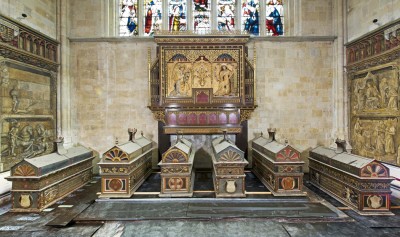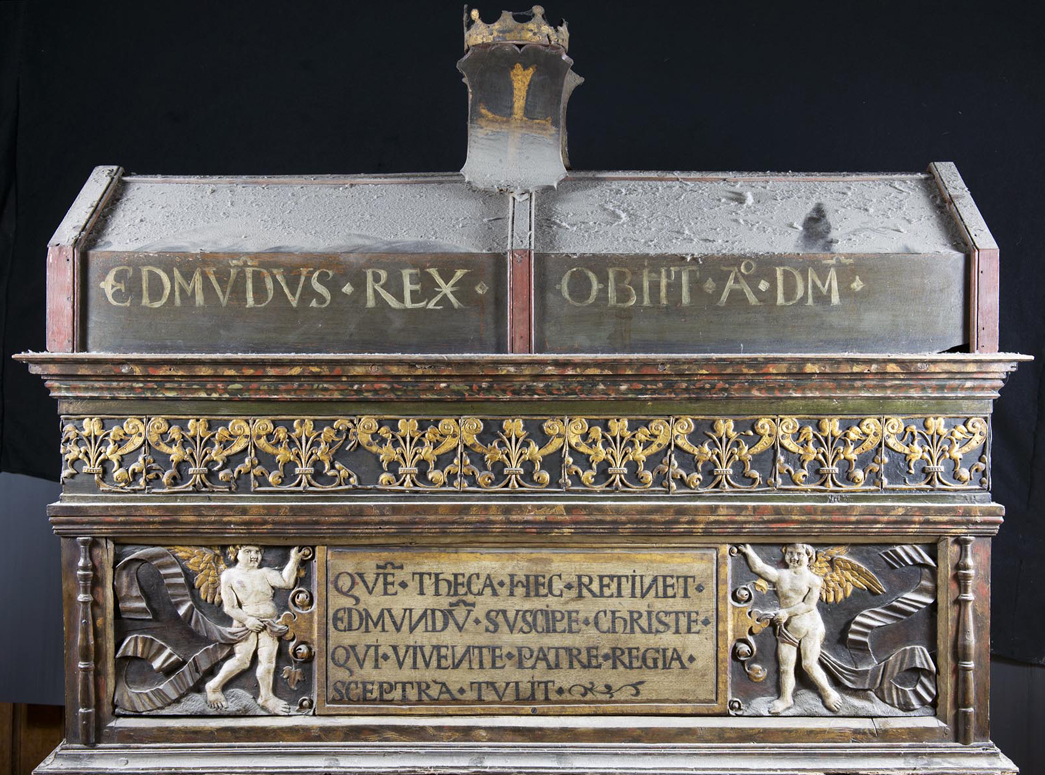A number of Renaissance mortuary chests in Winchester are believed to hold the remains of Anglo-Saxon and Viking kings of England. A project to record and analyse the contents has begun
The Dean and Chapter of Winchester has announced that, as part of an initial assessment of the Cathedral’s Renaissance Mortuary Chests and an inventory of their contents, a project to record and analyze the contents has begun. The chests are thought to contain the mortal remains of some of the early Royal Families of Wessex and of England – more specifically Cynegils († 643), Cynewulf († 786) Ecbert († 839), Æthelwulf († 858), Eadred († 955), Edmund ironside († 1016), Cnut († 1035), Hardecnut († 1042), Queen Emma († 1052) and William Rufus († 1100). The bones of three bishops – Wini († 670), Alfwyn († 1047) and Stigand († 1072) – are also believed to be kept there.
The chests and their contents have recently been resting in the Cathedral’s Lady Chapel and initial analysis has taken place on the chests themselves, with a view to their conservation as part of King’s and Scribes: The Birth of a Nation, which will bring to the Cathedral’s South Transept a three stage exhibition space, designed both to make more accessible the twelfth century Winchester Bible, but also to tell the stories about the Cathedral, to which its Anglo-Saxon origins are key.

A few days ago the Dean and Chapter was able to announce that some of the mortal remains in the Mortuary Chests had been formally dated by the Radiocarbon Accelerator Unit at the University of Oxford, and that their origins are thought to be from the late Anglo-Saxon and early Norman periods. This is consistent with the historical burial records of the named individuals.
Speaking of this discovery, and the coming project, The Dean of Winchester, The Very Revd James Atwell, says:
“This is an exciting moment for the Cathedral when we seem poised to discover that history has indeed safeguarded the mortal remains of some of the early Saxon Kings who became the first monarchs of a united England. Winchester holds the secrets of the birth of the English nation and it does seem that some of those secrets are about to be revealed as future research continues. The presence of the bones in the Cathedral, where they would have been placed near the High Altar and the relics of St Swithun, remind us just how significant the inspiration of the Christian faith was for the foundation of our national life.”
The Mortuary Chests
The contents of the Mortuary chests in question were seriously disturbed by Parliamentarian troops in 1642. Until then the contents of the chests had been carefully recorded. However, after the sacking of the Cathedral, the remains were apparently scooped up with no regard to proper identification.
Although the chests have been opened before in order to restore and clean them, the Cathedral has up until now refused to have the bones examined more scientifically. In spite of the interest of the public, such scientific scrutiny raises a number of ethical questions.
However, recent developments in forensic archaeology have now made it possible to examine the contents with a minimum of intervention and a greater certainty of accurate results; and the Dean and Chapter has given permission to a broader exploration of the chests and their contents.
The principal objectives of the current study are to
- Record the contents of each chest
- Determine the number of individuals, represented by the collection of co-mingled skeletons
- Determine the dates, which those individuals lived
- Determine – where possible – their sex, age of death and physical characteristics, such as stature.
The continued recording of the contents will be carried out by the University of Bristol. Already, though, we are told that some “unexpected contents have been found in the chests, which are not mortal remains”. One of the next stages of analysis will seek to discover what and why they have been placed in the chests. However, o more information about this mysterious artifacts have so-far seeped from the Dean and Chapter, which obviously hope to fire up under the imagination of the hoards of journalists, which need a new venue to flock around, when Richard III is finally laid to rest in April in Leicester.
The primary purpose of the project is definitely academic research. However, an undercurrent is definitely also to try and figure out which bones belonged to whom where possible (via DNA). This is however not stated publicly. Quite obviously, though, the stories might place Winchester Cathedral at the birth of the English Nation and establish it as the first formal national mausoleum, of similar importance to England as St Denis is to France and Speyer to Germany, says representatives of the Cathedral in the press release.
The Project Director is the Cathedral’s Receiver General, Canon Annabelle Boyes. “This welcome news marks a further stage towards achieving our aspirations to tell the stories of the people who have inspired and been inspired by the Cathedral.”
SOURCE:
The Mortuary Chests at Winchester Cathedral
Information Pack
Winchester Cathedral 2015
